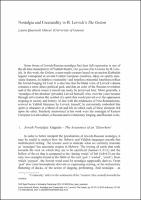Chapter Nostalgia and Creaturality in H. Leivick’s Тhe Golem
| dc.contributor.author | Quercioli Mincer, Laura | |
| dc.date.accessioned | 2022-06-01T12:06:35Z | |
| dc.date.available | 2022-06-01T12:06:35Z | |
| dc.date.issued | 2015 | |
| dc.identifier | ONIX_20220601_9788866558224_5 | |
| dc.identifier.issn | 2612-7679 | |
| dc.identifier.uri | https://library.oapen.org/handle/20.500.12657/55822 | |
| dc.description.abstract | This article examines some of the constituent elements of an often metaphysical "Jewish angst" or "Jewish toska" found in the Yiddish language drama "The Golem" (Der goylem, 1921). In this masterpiece by Russian Jewish writer H. Leivick, the renowned man-made clay giant clay of ancient Kabbalah legend, is the creature of sixteenth-century Rabbi Loew, the Maharal of Prague, and becomes an emblem of Jewish melancholic nostalgia. Such toska is directed simultaneously at the ontologically distant Creator, supremely unattainable, and at the equally unreachable messianic era. The Golem's sense of estrangement from his own existence, explored here in tandem with Leivick's biography, ultimately renders him a personification of nostalgia itself. | |
| dc.language | English | |
| dc.relation.ispartofseries | Biblioteca di Studi Slavistici | |
| dc.subject.other | H. Leivick | |
| dc.subject.other | Yiddish Literature | |
| dc.subject.other | Russian Symbolism | |
| dc.subject.other | Golem | |
| dc.subject.other | Jewish Mysticism | |
| dc.title | Chapter Nostalgia and Creaturality in H. Leivick’s Тhe Golem | |
| dc.type | chapter | |
| oapen.identifier.doi | 10.36253/978-88-6655-822-4.04 | |
| oapen.relation.isPublishedBy | bf65d21a-78e5-4ba2-983a-dbfa90962870 | |
| oapen.relation.isbn | 9788866558224 | |
| oapen.series.number | 28 | |
| oapen.pages | 18 | |
| oapen.place.publication | Florence |

